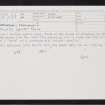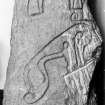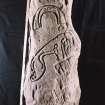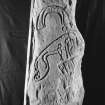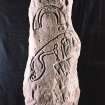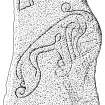Flemington, Aberlemno
Pictish Symbol Stone (Pictish)
Site Name Flemington, Aberlemno
Classification Pictish Symbol Stone (Pictish)
Alternative Name(s) Flemington Farm; Aberlemno 5
Canmore ID 34815
Site Number NO55NW 33
NGR NO 524 556
Datum OSGB36 - NGR
Permalink http://canmore.org.uk/site/34815
- Council Angus
- Parish Aberlemno
- Former Region Tayside
- Former District Angus
- Former County Angus
Aberlemno, Flemington Farm, Angus, Pictish symbol stone
Measurements: H 1.50m, W 0.53m, D 0.30m
Stone type: Old Red Sandstone
Place of discovery: NO 524 556
Present location: McManus Galleries, Dundee.
Evidence for discovery: found during ploughing in 1962
Present condition: weathered.
Description
This slab is incised with a horseshoe or arch symbol over a Pictish beast symbol.
Date range: seventh century.
Primary references: DES 1962, 1; Fraser 2008, no 52.
Desk-based information compiled by A Ritchie 2017.
Artefact Recovery (1961)
This Class 1 Pictish symbol stone, found in the course of ploughing in 1961, is now in Dundee Museum (Accession no: 1969-267); measuring 1.5m by 0.53m and 0.3m in thickness, it bears a 'beast' and a horseshoe with internal scrolls.
J D Boyd 1962; I Henderson 1964; H Coutts 1971; RCAHMS 1983; 1985.
Reference (1967)
Class I symbol stone - Aberlemno 5 - showing a horseshoe above an elephant.
A.Mack 1997
Note (1983)
Aberlemno NO 524 556 NO55NW 33
In 1962 a Class I Pictish symbol stone (DMAG 1969-267) was ploughed up to the E of Aberlemno church. It bears two symbols, namely a horseshoe and an elephant.
RCAHMS 1983
(Henderson 1962; Coutts 1971a, 84, no. 188)
Field Visit (July 2005)
Excavation (February 2022)
NO 52503 55725 Seven trenches were opened at Flemington, Aberlemno, in February 2022, to test a number of geophysical anomalies detected in 2021, as well as to continue excavation of the large, stone-slabbed structure with Pictish symbol stone and Bronze Age cup marked stone and to facilitate their extraction for preservation.
Trench 1 was positioned over the northern perimeter of a double-palisaded enclosure surrounding a stone slab structure. This revealed two U-shaped palisade cuts spaced approximately
1.5m apart, which are likely to be contemporary.
Trench 2 was opened over a large square anomaly recorded in the geophysics results. This anomaly was interpreted as a possible structure, set within the double-palisaded enclosure. In April 2021, a 6 x 3m trench was opened over the southern edge of this possible structure. Excavation revealed a monumental stone slab floor a ssociated w ith t he s outhern edge of a b uilding, w ith multiple floor layers surviving underneath which have been dated to the Pictish period.
Trench 3 was excavated approximately 10m to the N of Trench 2 to test if the monumental stone floor extends in this direction. The trench confirmed the presence of the stone floor and identified a possible hearth set within it.
Trench 4 was opened over a geophysical anomaly that suggested high magnetic responses, perhaps a metalworking area. The trench confirmed the presence of a large pit, which contained abundant charcoal and frequent large pieces of metalworking slag, with some recovered fragments of tap slag.
Trench 6 consisted of the enlargement of Trench 2, which was expanded to facilitate extraction of the carved stones and safely test underlying deposits. The extension also identified the corner of a second monumental stone floor at t he s outhern side of the trench. A sondage through the stone floor layer abutting the Pictish symbol stone revealed a number of postholes at the lowest level, cut into the underlying natural. Sitting above these postholes were a series of introduced clayey-silt floor layers, one of which contained the remains of a possible metalworking furnace with an in situ iron furnace base.
A second trench (Trench 7) was opened over the double- palisaded enclosure at its western side. Here again, the presence, size and shape of the palisade was confirmed.
Trench 8 was located to the E of Trench 6 and was opened at the centre of a geophysical anomaly similar to the response given from the stone slab floor. It was posited that the eastern anomaly represented another large building positioned outside the double- palisaded enclosure (though it is likely that the palisades were related to an earlier phase of use, and as such, these would not have separated the structures). It confirmed that this was another possible monumental stone-floor structure and identified a large central post.
Archive: University of Aberdeen
Funder: Leverhulme Trust and University of Aberdeen
James O’Driscoll and Gordon Noble – University of Aberdeen
(Source DES Volume 23)
Photographic Survey
Photographed, no date recorded but published in Proceedings of the Society of Antiquaries vol. 95, 1961-2.














